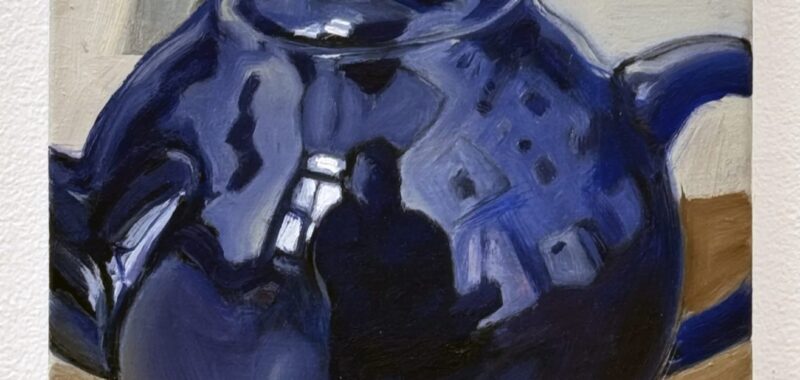The stress of 2025 is no doubt taking a physical toll — so it’s timely that New York University’s MFA cohort is reckoning with their bodies in the second part of their senior thesis show. This exhibition is not preoccupied with body image, nor restating the obvious about social media-induced dysphoria. It’s more about coming up with novel ways to think about the bodies we inhabit, the stresses they carry, and what they can and can’t perceive.
Finley Doyle offers a self-portrait on a blue teapot in the oil painting “On another scale” (2024). Photos are depicted pinned onto her studio’s wall in the background, portraying the artist’s mermaid Barbie doll on the ledge of a bathtub (left) and herself as a child with her sisters and mother in the bathtub (right). On one level, Doyle wanted to use the teapot’s twisted reflection as a way to explore distorted representations such as Barbie, as well as the lessons her family imparted about the body. Doyle’s obscured torso contrasts with the carefully delineated architectural space of the studio, nodding to Parmigianino’s “Self-Portrait in a Convex Mirror” (c. 1524), and alluding to the pressure many women can feel to blend in with their environment, erasing themselves in the process.

In his sculpture “Dominion” (2025), Nick O’Connell reckons with the limits of what the body can perceive and the ways that its blind spots can unknowingly dominate us. On the top stage of this intentionally enigmatic sculpture is a 3D-printed resin recreation of the famous Roman sculpture the Laocoön, with a twist — only the body parts constricted by the sea serpents are rendered. On the middle tier, a device emits light onto an underlit scanner bed with three discarded plastic gloves. On the bottom, bicycle cogs dangle over a pillow. That element in particular feels intentionally cryptic, as if to signal the limit of what can be gleaned by sight alone.

Lizzy Choi’s wearable sculpture, “Ctenophora” (2025), is a matching corset, underwear, and sunglasses set typically displayed on the gallery wall, though a model wore it at the opening. The ribbing on the corset is meant to evoke the comb jellyfish, alluding to how concepts of gender can similarly menace individuals. “I like to employ aggression in my work as a tool to carry my ideas,” Choi explained to Hyperallergic. While underwear is typically encoded with dysmorphic beauty standards, Choi’s fearsome alternative fights back against patriarchal norms.

Chloe Mosbacher likewise looks towards the animal kingdom in her drawings of bumblebees, butterflies, and ladybugs, inviting us to ponder these insects’ bodies enlarged at 4500%. “I wanted to scale them up to problematize our relationship to them,” Mosbacher explained. Although we depend upon the labor of pollinators for our produce, every species of bee and butterfly depicted is either vulnerable or imperiled in New York State. Before Trump’s election, the monarch butterfly was on track to become designated as a threatened species under the Endangered Species Act; now, that effort has stalled, and conservationists expect a full veto to come. Mosbacher’s drawings ask why many of us take insects for granted when our bodies can’t live without the fresh food they help produce.

Wyatt Nelson’s sculpture “Circling the Wagons” (2025) offers a nuanced critique of colonial herd mentality in the round. His 3-D printed Conestoga wagons invoke the United States’s grisly settler history. Peering through them, one discovers a herd of identical miniature white king figurines encircling glowing silicone like a bonfire. A sinister hooded goblin with a motherboard looms over them, suggesting their obedience. It’s a powerful critique of White power and technocapitalism via unorthodox metaphors.
Another show about the body in art doesn’t sound so original. But NYU’s MFA cohort proves that the body and its perceptions, cravings, delusions, blind spots, and its affinities and divergences with animal bodies, can still offer new imagery and fresh metaphors.

The New York University MFA Class of 2025 Thesis Show: Part 2 is on view at the 80 WSE (80 Washington Square East, Greenwich Village, Manhattan) until May 24. The exhibition was organized by the institution.

